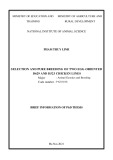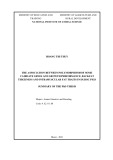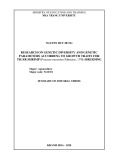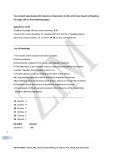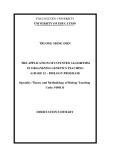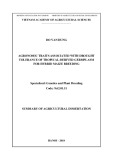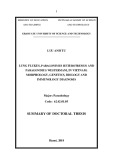doi:10.1046/j.1432-1033.2003.03659.x
Eur. J. Biochem. 270, 2937–2944 (2003) (cid:2) FEBS 2003
The calcium-induced switch in the troponin complex probed by fluorescent mutants of troponin I
1
Deodoro C. S. G. Oliveira and Fernando C. Reinach
Departamento de Bioquı´mica, Instituto de Quı´mica, Universidade de Sa˜o Paulo, Brazil
modulator of the Ca2+ affinity of TnC; we show that point mutations and incorporation of 5HW in TnI can affect both the affinity and the cooperativity of Ca2+ binding to TnC. We also discuss the possibility that the regulatory sites in the N-terminal domain of TnC might be the high affinity Ca2+-binding sites in the troponin complex.
Keywords: 5-hydroxytryptophan; Ca2+-binding protein; fluorescence; troponin; skeletal muscle.
The Ca2+-induced transition in the troponin complex (Tn) regulates vertebrate striated muscle contraction. Tn was reconstituted with recombinant forms of troponin I (TnI) containing a single intrinsic 5-hydroxytryptophan (5HW). Fluorescence analysis of these mutants of TnI demonstrate that the regions in TnI that respond to Ca2+ binding to the regulatory N-domain of TnC are the inhibitory region (residues 96–116) and a neighboring region that includes position 121. Our data confirms the role of TnI as a
2
The regulation of striated muscle contraction in vertebrates is accomplished by troponin (Tn), a protein associated with actin in the thin filament. Tn is a complex composed of three polypeptide subunits: troponin C (TnC) has the Ca2+- binding sites, troponin I (TnI) has the inhibitory function, and troponin T (TnT) is the actin–tropomyosin-binding component. Tn works as a sensor of intracellular calcium concentration. Stimulation of the muscle leads to Ca2+ increase, and Ca2+ binding to TnC removes the inhibition of the muscle contraction promoted by TnI. The conform- ational transition undergone by Tn enables the regulation of muscle contraction [1–3].
This article describes the use of fluorescent mutants of TnI to investigate the Ca2+-induced switch in Tn. Each mutant contains a single intrinsic 5-hydroxytryptophan (5HW), a tryptophan analog. The unique 5HW can be selectively monitored in the presence of several W and works as a site-specific probe for conformational rearrange- ments [11,12]. Our results demonstrate that the inhibitory region and the adjacent region including residue 121 of TnI undergo conformational transitions triggered by Ca2+. Further, the data enables us to better understand the influence of TnI on the calcium binding properties of TnC. We also report for the troponin complex a surprisingly high Ca2+-affinity assigned to the regulatory sites in the N-domain of TnC.
Experimental procedures
Construction of TnI mutants
oligonucleotide-mediated mutagenesis
TnC has two globular domains connected by an a-helix and each domain has two Ca2+-binding sites (EF-hand motifs) [4]. The Ca2+-binding properties of isolated TnC are well known. Sites III and IV in the C-domain (carboxy terminal) bind Ca2+ with higher affinity, while sites I and II in the N-domain (amino terminal) bind Ca2+ with lower affinity [5,6]. The association between TnC and TnI was shown to be antiparallel [7]. The C-domain of TnC interacts structurally with the N-terminal region of TnI [8,9]. The Ca2+-loaded N-domain has a higher affinity for TnI and triggers a chain of conformational rearrangements that moves the inhibitory region of TnI, residues 96–116, away from actin [10]. The full regulatory properties are only achieved in the presence of TnT [8].
technique The [13,14] was used to replace the single W codon at position 160 in the chicken fast skeletal muscle cDNA cloned into the phage M13 [15]. It generated the phage M13-TnIW160F (TnIW-less), which was used as the template to construct two other mutants. M13-TnIF106W and M13-TnIF177W, respectively, had F106 and F177 mutated to W (Fig. 1A). The mutagenic primers used were: W160F 5¢-TGGGTG ACTTCAGGAAGAACA-3¢, F106W 5¢-GGGCAAGT GGAAGAGGCCA-3¢, F177W 5¢-GAAGAAGATGTG GGAGGCCGG-3¢. The mutant TnI cDNA inserts were released by digestion with the restriction enzymes NdeI and BamHI, and subcloned in the expression vector pET3a [16]. The mutants TnIY79W, TnIF100W and TnIM121W were engineered by PCR [17] using the vector pET-TnIW160F (TnIW-less) as a template. W replaced, respectively, Y79, F100 and M121 (Fig. 1A). The oligonucleotides used were: Y79W, 5¢-GGATGAGGAAAGGTGGGACACA GAG-3¢; Y79W(rev), 5¢-TCACCTCTGTGTCCCACCTT TCCTC-3¢; F100W, 5¢-GAGCCAGAAGCTGTGGGA
Correspondence to F. C. Reinach, Departamento de Bioquı´ mica, Instituto de Quı´ mica, Universidade de Sa˜ o Paulo, CEP 05599–970, Sa˜ o Paulo, SP, Brazil. Fax: + 55 11 3815 5579, Tel.: + 55 11 3818 3713, E-mail: fdcreina@quim.iq.usp.br Abbreviations: Tn, troponin complex; TnI, skeletal troponin I; 5HW, 5-hydroxytryptophan; TnC, skeletal troponin C; TnT, skeletal troponin T. (Received 10 October 2002, revised 1 May 2003, accepted 12 May 2003)
2938 D. C. S. G. Oliveira and F. C. Reinach (Eur. J. Biochem. 270)
(cid:2) FEBS 2003
Fig. 1. Schematic model of TnC and TnI. (A) The structural Ca2+- binding sites III and IV of TnC are circled and the regulatory Ca2+- binding sites I and II of TnC are represented with grey circles. The inhibitory region of TnI is highlighted in dark grey, the proposed modulatory region of TnI is highlighted in light grey. The original amino acid residues of each mutated position in TnI are indicated. In each mutant only one position was mutated to W, represented as empty bars. The natural W replaced by F in all double mutants is represented by a filled bar. The antiparallel interaction of TnI and TnC is illustrated. (B) Comparison of the structure of W and 5HW. Our recombinant protein expression system incorporates 5HW in W codon positions. lane 7, TnC-TnIM121HW; (C) SDS/PAGE of lane 9, TnC-TnIF177HW.
products with NdeI/BamHI
CCTGAG-3¢; F100W(rev), 5¢-GCCCCTCAGGTCCCAC AGCTTCTG-3¢; M121W, 5¢-GTCTGCTGATGCCTGG CTGCGTG-3¢; M121W(rev), 5¢-CAGGGCACGCAGC CAGGCATCAG-3¢; T7 promoter, 5¢-TACGACTCAC TATAGGGAGACCAC-3¢; T7 terminator, 5¢-TAGTTAT TGCTCAGCGGTGGCAGC-3¢. The digestion of the amplification released the complete cDNA of TnI allowing subcloning in pET3a [16]. All mutations were confirmed by DNA sequencing [18].
Protein preparation
collected by centrifugation. Purification was as described for recombinant TnI [15]. All mutants of TnI behaved as TnI in purification steps (data not shown) and had the same electrophoresis polyacrylamide gel mobility (Fig. 2). The amount of purified TnI with 5HW incorporated was between 5 and 10 mgÆL)1 of culture. The 5HW incorpor- ation ratio for this method was estimated to be higher than 90% [12]. Recombinant TnT was obtained as described [8]. Recombinant TnC [15] and the mutants of TnC, TnCF29W [20], or TnCD30A, TnCD66A, TnCD106A, and TnCD142A [7] are described elsewhere. All forms of TnC were prepared as in Fujimori et al. [21].
The ability of TnC to form a stable complex with each mutant TnI was visualized through urea/PAGE [7,22]. The concentration of protein was determined with the technique described by Hartree [23]. The SDS/PAGE was done as described in Laemmli [24].
Troponin complex reconstitution
The binary and ternary (Fig. 2C) complexes were reconsti- tuted as described previously [7] with some modifications. Equimolar amounts of protein were mixed and sequentially
The 5HW was incorporated into recombinant proteins using the Escherichia coli lineage CY(DE3)pLysS [12]. This is a lineage auxotrophic for W [19], which was modified for use with the pET system [16]. The proteins were expressed with the following protocol: a transformed colony with the desired vector was grown in 50 mL minimal media (M9) plus 50 mgÆL)1 L-tryptophan, 200 mgÆL)1 carbenicillin, and 200 mgÆL)1 chloramphenicol succinate, at 37 (cid:3)C. This culture was used to inoculate 4 L of the same media. When the D600 of the culture reached 0.8–1.0, the bacteria were recovered by centrifugation (3000 g, 4 (cid:3)C, 15 min). The bacteria were then resuspended in the same media with 0.4 mM isopropyl thio-b-D-galactoside and without L-tryp- tophan. After 15 min, 100 mgÆL)1 L-5-hydroxytryptophan was added. The bacterial culture was incubated for 3 h and
Fig. 2. Urea/PAGE analysis and reconstitution of troponin complexes. The ability of each mutant TnI to bind TnC was assessed by urea/ PAGE in the presence of (A) 0.5 mM EDTA and (B) 0.5 mM Ca2+. In the absence of Ca2+ only the band of free TnC is visible in the gel. When Ca2+ is present there is a second band corresponding to the binary complex, TnC-TnI. Lane 1, TnC; lane 2, TnC-TnI; lane 3, TnC- TnIW-less; lane 4, TnC-TnIY79HW; lane 5, TnC-TnIF100HW; lane 6, lane 8, TnC- TnC-TnIF106HW; the TnI160HW; reconstituted ternary complexes with all TnI mutants, TnC and TnT. Lane 1, Tn; lane 2, Tn-TnIW-less; lane 3, Tn-TnIY79HW; lane 4, Tn-TnIF100HW; lane 5, Tn-TnIF106HW; lane 6, Tn-TnIM121HW; lane 7, Tn-TnI160HW; lane 8, Tn-TnIF177HW.
The calcium-induced switch in the troponin complex (Eur. J. Biochem. 270) 2939
(cid:2) FEBS 2003
dialyzed against the following buffers: (a) 50 mM Tris/HCl pH 8.0, 4.6 M urea, 1 M KCl, 50 lM CaCl2, 0.01% NaN3, 10 mM 2-mercaptoethanol; (b) 50 mM Tris/HCl pH 8.0, 2 M urea, 1 M KCl, 50 lM CaCl2, 0.01% NaN3, 10 mM 2-mercaptoethanol; (c) 50 mM Mops pH 7.0, 1 M KCl, 5 lM CaCl2, 0.01% NaN3, 10 mM 2-mercaptoethanol; and three times against the fluorescence buffer: (d) 50 mM Mops pH 7.0, 100 mM KCl, 1 mM EGTA, 0.01% NaN3, 10 mM 2-mercaptoethanol. The aggregated proteins were removed by centrifugation (10 000 g, 15 min, 4 (cid:3)C).
Fluorescence experiments
Fluorescence spectra were determined with a Hitachi F-4500 spectrofluorimeter. For the excitation spectra, the emission was collected at 340 nm. For the emission spectra, the excitation was at 315 nm. The band slits were always 5 nm for both emission and excitation. The samples were diluted in fluorescence buffer to a concentration of 2 lM, in a final volume of 1.5 mL. We allowed the protein to equilibrate for 20 min at 25 (cid:3)C before initiating the experiment. Fluorescence buffer plus 5 mM CaCl2 or 50 mM CaCl2 was used in the titration experiments. The free Ca2+ concentration was calculated using the software SLIDERS [25]. A single scan was performed for each Ca2+ addition and the total area of the emission spectra between 325 and 345 nm was used to plot the titration curves.
Results
We produced six different recombinant TnIs with a single 5HW in positions we aimed to investigate: TnIY79HW, TnIF100HW, TnIF106HW, TnIM121HW, TnI160HW, and TnIF177HW (Fig. 1A). Binary and ternary troponin complexes were reconstituted for fluorescence analysis from their recombinant subunits (Fig. 2C). The advantage of this strategy is that the 5HW can be selectively excited between 310 and 320 nm in the presence of several W residues (Fig. 3A). Therefore, the fluorescence of the single 5HW in TnI can be monitored in the presence of three W from TnT [26]; TnC does not contain W [27].
The urea/PAGE experiment permits visualization of the TnC–TnI interaction (Fig. 2). Due to its negative charge TnC enters the gel while the positively charged TnI does not. The interaction between TnC and TnI is so strong when calcium is present (0.5 mM CaCl2) that TnC is able to carry TnI into the gel [7,22]. In the absence of calcium (0.5 mM EDTA or 10 mM MgCl2/1 mM EGTA, data not shown) TnC enters alone. All TnI mutants exhibit the same behavior as TnI. This demonstrates that the mutations and the incorporation of 5HW in TnI do not strongly affect the Ca2+-dependent interaction with TnC.
within Tn. The highest variation obtained is a 70% increase in the fluorescence of the ternary complex Tn-TnIM121HW in the calcium-saturated state (pCa 4) as compared to the Apo state (Fig. 3C). The presence of Ca2+ also promotes a consistent 12% increase in the emission spectra of Tn-TnIF100HW (Fig. 3B). Two binary complexes TnC- TnIF106HW and TnC-TnIM121HW (data not shown) present significant variation in fluorescence emission. The complexes with TnIY79HW, TnI160HW and TnIF177HW, however, are not sensitive to the addition of calcium (i.e. the fluorescence intensity changes are lower than 3%). In summary, the data from TnI fluorescent mutants show that the portion of TnI that responds to Ca2+ binding to TnC is the inhibitory region plus a neighboring region that includes position 121 (Fig. 1A).
Regions of TnI sensitive to calcium binding to TnC To determine which regions of TnI are sensitive to Ca2+ binding to TnC, we compared the fluorescence emission spectra of the reconstituted complexes in the absence and presence of calcium. Because changes in the environment around a fluourophore affect its fluorescent properties, the 5HW is a site-specific probe for allosteric modifications
Following the identification of the complexes that display a fluorescence signal, Ca2+ titration experiments were
Fig. 3. The 5HW fluorescent mutants of TnI. (A) Comparison between excitation spectra of Tn (dotted line) and the fluorescence Tn-TnI160HW (solid line). The dotted vertical line shows that the single 5HW of TnI160HW can be selectively excited at 315 nm in the presence of three W from TnT. As TnI160HW has the wild-type sequence, these two complexes are different only with respect to the hydroxyl group present in 5HW. Two ternary troponin complexes reconstituted with fluorescent mutants of TnI were sensitive to Ca2+ binding: (B) Tn-TnIF100HW and (C) Tn-TnIM121HW showed significant increase in the fluorescence emission spectra in the Ca2+ saturated state, pCa 4 (solid lines) compared to the Apo state (dotted lines).
2940 D. C. S. G. Oliveira and F. C. Reinach (Eur. J. Biochem. 270)
(cid:2) FEBS 2003
Table 1. Fluorescence emission titration curves parameters. The data from Ca2+ titration of fluorescence emission was adjusted to the equation: DF ¼ (DFmax · [Ca2+]n)/(Kn d + [Ca2+]n), where DF is the fluorescence variation, DFmax is the maximum fluorescence variation, Kd is the apparent Ca2+ dissociation constant and n is the Hill coef- ficient. For TnC-TnIF106HW only, we used an equation that des- cribes a biphasic curve: DF ¼ (DFmax1 · [Ca2+]n1)/(Kn1 d1 + [Ca2+]n1)/ (DFmax2 · [Ca2+]n2)/(Kn2 d2 + [Ca2+]n2), DF is the fluorescence vari- ation, DFmax1 is the maximum fluorescence variation, Kd1 is the apparent Ca2+ dissociation constant and n1 is the Hill coefficient for the first part of the curve, Fmax2 is the maximum fluorescence variation, Kd2 is the apparent Ca2+ dissociation constant and n2 is the Hill coefficient for the second part of the curve (shown in parentheses). The values presented are the average and SD of three independent titrations.
Complex n DFmax Kd (M)
TnC-TnIF106HW
)6% (+3%) +12% +10% +70% +500% +500% +450% 4.5 ± 0.3 e)8 (2.8 ± 0.5 e)6) 3.1 ± 0.7 e)8 4.7 ± 1.1 e)7 3.3 ± 0.1 e)7 7.6 ± 1.6 e)6 6.4 ± 0.4 e)7 5.8 ± 0.1 e)7 1.2 ± 0.2 (1.0 ± 0.3) 1.0 ± 0.1 2.0 ± 0.4 1.9 ± 0.1 1.0 ± 0.1 1.1 ± 0.1 1.0 ± 0.1 Tn-TnIF100HW TnC-TnIM121HW Tn-TnIM121HW TnCF29HW TnCF29HW-TnI Tn-TnCF29HW
Identification of the TnC domain perceived by the TnI mutants
To determine whether the observed variation in Kd and n is due to mutations or different phenomena, Tn was recon- stituted with a set of four TnC mutants combined with TnIF100HW or TnIM121HW. There is an aspartic acid involved in metal ion coordination in the first position of all EF-hands of TnC. This allowed each one of the Ca2+- binding sites to be disrupted by a D fi A replacement: TnCD30A (site I), TnCD66A (site II), TnCD106A (site III), and TnCD142A (site IV) [7,29].
performed. Two important parameters are acquired, the affinity for Ca2+, dissociation constant (Kd), and the cooperativity (n) of Ca2+ binding (Table 1). The TnC- TnIF106HW shows a curve characterized by an initial decrease in the fluorescence intensity ()6%, Kd1 ¼ 4.5 · 10)8 M) followed by an increase (3%, Kd2 ¼ 2.8 · 10)6 M, Fig. 4B). Therefore, TnIF106HW may be a probe for calcium binding to both domains of TnC. The param- eters for Tn-TnIF100HW are in agreement with the first part of the curve of TnC-TnIF106HW for both Kd and n (Fig. 4A). Positions 100 and 106 are part of the inhibitory region and respond to the same event, Ca2+ filling a high affinity class of sites. The probe at position 121 of TnI shows a Kd consistent with the occupancy of a lower affinity Ca2+- binding site with a very high cooperativity, n (cid:2) 2. This value indicates that two sites are occupied by Ca2+ at nearly the same time. Although we analyzed TnC-TnIM121HW as a one-step curve, this binary complex shows a decrease at low pCa in the titration curve (Fig. 4B). This decrease may also be an indication of Ca2+ binding to a different class of sites.
Neither the calcium affinity nor the cooperativity dis- played by TnC are affected by mutations in sites III and IV. The Tn with a disrupted site IV (TnCD142A) shows the same calcium titration curve as the respective complex with TnC. Similarly, TnCD106A, which prevents Ca2+ binding to site III, has no effect on the curve of TnIF100HW and only slightly lowers the intensity change of TnIM121HW. This small decrease in the intensity change is likely to be due to interdomain communication. It demonstrates that the probes at positions 100 and 121 of TnI are not sensitive to calcium binding to structural sites III and IV in the C-domain of TnC (Fig. 5).
The TnC mutant TnCF29HW (where F29 was mutated to W and 5HW incorporated) is a probe for Ca2+ filling the sites in the N-domain [20,28]. The presence of TnI increases the Ca2+-affinity of the regulatory sites of TnC by one order of magnitude, and TnT has no further effect (Fig. 4C and Table 1). Although the Kd values acquired are only slightly different in comparison with the respective TnIM121HW binary and ternary complexes, TnCF29HW does not display Ca2+-cooperative binding. It appears that there are three different sets of data: one for probes in the inhibitory region of TnI, another for the probe at position 121 of TnI, and a third for the probe in the N-domain of TnC.
The complexes reconstituted with TnCD30A are charac- terized by a lower amplitude of fluorescence variation; the
Fig. 4. Calcium titration of the fluorescent troponin complexes. (A) Ternary complexes Tn-TnIF100HW and Tn-TnIM121HW; (B) Bin- ary complexes TnC-TnIF106HW and TnC-TnIM121HW; (C) TnCF29HW, TnCF29HW-TnI and Tn-TnCF29HW. The data is an average of three independent experiments, the error bars show the respective SD. Lines are the best fit for the equations presented in Table 1.
The calcium-induced switch in the troponin complex (Eur. J. Biochem. 270) 2941
(cid:2) FEBS 2003
of TnI, followed the Ca2+-binding to the N-domain of TnC. The variation in Kd and n are likely to be due to the mutations rather than to Ca2+ binding to different sites. Previous studies have shown site-directed point mutations in TnC that altered the Ca2+-binding properties of TnC [20,21,31]. Here we present evidence that point mutations in the TnI alter the dissociation constant and the cooper- ativity of Ca2+ binding to TnC. This study further eluci- dates the TnI modulatory role in the TnC Ca2+-affinity.
Discussion
Several studies have reported the use of naturally occurring fluorescent amino acids, tyrosine or tryptophan, or the use of proteins labeled with extrinsic attached probes to analyze ligand binding, protein–protein interaction and folding pathways [6,20,32–38]. However, the use of Y and W is limited because the interpretation of the data becomes difficult if more than one is present. The use of attached extrinsic fluorescent probes may lead to protein structural alterations due to their relative large size and potential for forming or disrupting interactions. The incorporation of 5HW and other non-naturally occurring amino acid analogs into a protein seems to be a good alternative. They can be used as site-specific probes, with an expected lower conformational damage [11,12,28]. We demonstrate here that it is possible to construct fluorescent recombinant mutants of TnI that have their emission spectra affected by Ca2+ binding to TnC, a different polypeptide chain. We were able to follow the fluorescent signal to investigate the information of Ca2+ binding to the regulatory sites in TnC transmitted to TnI and to analyze the modulatory effect of TnI on Ca2+-binding properties of TnC.
The calcium-induced switch
affinity constants, however, are not affected. All complexes with TnIM121HW where TnC has two functional sites in the N-domain show strong cooperativity ((cid:2) 2, Table 1, Figs 4 and 5B). However, TnCD30A has only one functional site in the regulatory domain and cooperativity would be impossible; in fact TnCD30A drops the n-value to 1 (Fig. 5B). This implies that the presence of a 5HW in position 121 of TnI promotes cooperativity among the regulatory sites of TnC. Figure 5A,B clearly shows the strong disturbance of the calcium titration curve shapes upon replacement of D66 by A. Recent data have confirmed that this mutation severely decreases the Ca2+ affinity of the regulatory domain of TnC, affecting not only site II but also site I [30]. These results indicate that the inhibitory region and position 121 of TnI are sensitive to the calcium- triggering signal from the N-domain of TnC.
Fluorescence analysis was undertaken for this group of D fi A TnC mutants, and TnIF106HW or TnIF106W (the same TnI mutant with W instead of 5HW, data not shown). As TnC does not contain W [27], the fluorescence of the single W of TnIF106W can be selectively excited at 295 nm. TnIF106W follows the same pattern as TnIF106HW. The variation in the fluorescence signal is, however, slightly larger, characterized by a 10% decrease in the first part of the curve and a 4% increase in the second part (data not shown). Disruption of site I and in particular site II modifies the first part of the signal. This indicates that the high affinity Ca2+ signal is related to the N-domain. Further, the disruption of the sites in the C-domain affects the lower affinity part of the signal. The difference in the second part of the curve, however, is too small to permit any firm conclusion.
The regulatory TnC domain loaded with calcium exposes a hydrophobic surface [38,39]. Recently, many studies have pointed out that the part of TnI that interacts with this hydrophobic pocket is a region adjacent to the C-terminal end of the inhibitory sequence [28,36,40–43]. Furthermore, M121 of TnI has been considered a fundamental residue in this interaction [9,42,43]. The fluorescence changes of 5HW at position 121 promoted by Ca2+ support this idea. Consequently, the inhibitory region, positions 96–116 [10], may bind elsewhere, instead of the hydrophobic pocket [7,34–36,44]. Our findings show that TnC-TnIF106HW and Tn-TnIF100HW are sensitive to Ca2+ binding to the regulatory domain of TnC. It demonstrates that even if the positions 100 and 106 of TnI do not interact directly with the N-domain, calcium promotes conformational rear- rangements that are transmitted to the inhibitory region of TnI, the main event in the regulation of muscle contraction. The probes in the N- and C-terminal regions of TnI, TnIF79HW, TnI160HW and TnIF177HW, do not display variation in the fluorescence spectra promoted by Ca2+, and this suggests that calcium occupying the TnC sites causes little structural modification in these regions. The N-terminal region of TnI, positions 1–95, seems to have mainly a structural function in maintaining the organization of the Tn [7–9,45]. The function of the C-terminal region of TnI is less understood. Mapping of the TnI interactions
All three data sets, the results for 5HW in the N-domain of TnC, in the inhibitory region of TnI and at position 121
Fig. 5. Calcium titration of ternary troponin complexes with the fluor- escent TnI and TnC, TnCD30A, TnCD66A, TnCD106A, TnCD142A. (A) Ternary troponin complexes with TnIF100HW. (B) Ternary troponin complexes with TnIM121HW. The data is an average of three independent experiments; the error bars show the respective SD.
2942 D. C. S. G. Oliveira and F. C. Reinach (Eur. J. Biochem. 270)
(cid:2) FEBS 2003
4
with the other thin filament proteins obtained by photo- crosslinking is consistent with this scheme [46].
The amplitude of the variation in the emission spectra promoted by Ca2+ is different for binary and ternary com- plexes. TnIF100HW shows variation only for the ternary complex, TnIF106HW shows variation only forming the binary complex, and TnC-TnIM121HW presents a 10% increase while Tn-TnIM121HW displays a 70% increase. These results indicate that TnT causes alterations in the environment around the TnI regions involved in the regulatory process, reflecting the structural flexibility of the middle part of TnI [44].
to sites I and II of TnC. Also, the previously been related N-domain was linked to the first part of the bimodal Ca2+ titration curves of the binary complexes. Together, these could be evidence that the high affinity sites are in the N-domain when TnC is bound to TnI. The literature has little information about the Ca2+ affinity of each domain of TnC when bound to TnI, perhaps because it has not been previously considered. Data from extrinsic attached probes, usually on C98 of TnC, are sensitive to Ca2+ binding to the two classes of sites, and the authors interpreted the high affinity sites being in the C-domain and the low affinity in the N-domain of TnC. Nevertheless an absolute assignment could not be made [32, 33 and references therein]. Other workers have reported that the Ca2+ affinity of the struc- tural C-domain increases when in the presence of a molar excess of the inhibitory peptide [34–36], however, this may be a nonphysiological interaction [9,44,48].
TnI modulatory effect in TnC Ca2+ affinity Since the original experiments of Ca2+-binding done by Potter and Gergely [5], it has become clear that TnI modulates the TnC affinity for calcium. At that time, the structure of TnC and the relative independence of the N- and C-domains were unknown [4], and there had been no identification of the low and the high affinity sites. When Leavis et al. [6] used proteolytic fragments of TnC to identify the high affinity sites in the C-domain and the low affinity sites in the N-domain, it was assumed to be the case for TnC-TnI and Tn also. It has been considered that TnI increases the Ca2+ affinity of both domains by one order of magnitude. Several studies have supported the conclusions for TnC alone [20,21,35,37,47,48].
It was tempting to propose a hypothesis that the regulatory sites I and II of TnC are the higher Ca2+ affinity sites in troponin complex. Nevertheless, we are convinced that carefully planed experiments using whole troponin and direct assignment of each Ca2+-binding site are required to solve the question. Our data showed that small modifica- tions, like a point mutation and a quite noninvasive probe in TnI, can affect both affinity and cooperativity of the TnC Ca2+-binding sites. Further more, we should be aware that as the properties of free TnC are not equal to the TnC in troponin complex, in the same way, conclusions reached for Tn alone might not represent the thin filament conditions, where Tn is likely to be strongly affected by the interaction with actin-tropomyosin.
Acknowledgements
We thank Chuck Shaker Farah for assistance in several stages of the work. We are grateful to Fernando Fortes Valencia who provided valuable help during this study. This work was supported by grants from Fundac¸ a˜ o de Amparo a` Pesquisa do Estado de Sa˜ o Paulo, Conselho Nacional de Pesquisa and the Howard Hughes Medical Institute. DCSGO was a graduate fellow of FAPESP and CNPq.
References
1. Farah, C.S. & Reinach, F.C. (1995) The troponin complex and regulation of muscle contraction. FASEB J. 9, 755–767.
2. Squire, J.M. & Morris, E.P. (1998) A new look at thin filament regulation in vertebrate skeletal muscle. FASEB J. 12, 761–771. 3. Gordon, A.M., Homsher, E. & Regnier, M. (2000) Regulation of contraction in striated muscle. Physiol. Rev. 80, 853–924.
The 5OH mutants allowed us to investigate the Ca2+ affinity of TnC when forming the troponin complex using full-length proteins. However, the results are puzzling. The Tn-TnCF29HW and TnCF29HW-TnI show one order of magnitude increase in the affinity of the regulatory sites for calcium in comparison with TnCF29HW alone (Table 1 and Fig. 4C [28]). This is in agreement with the scenario described above. It is important to note that F29 is part of the hydrophobic surface exposed in the open (Ca2+-loaded) N-domain [38,39]. There is evidence that this position influences the Ca2+ affinity of the N-domain [30], and the replacement of F by W impairs the regulatory properties of TnC [49]. It is difficult to explain how the presence of 5OH at position 121 can promote cooperativity among sites I and II. Regardless, the work of other researchers showed that position 121 can be photocrosslinked with residues in the hydrophobic pocket [42], that alterations in M121 or in the region nearby reduce the Ca2+-dependent interaction with TnC [43], and also indicated the importance of the TnI residues 117–129 to modulate the Ca2+ affinity of the N-domain [28]. Accordingly, it is not surprising that the 5OH at position 121 has an effect on the Ca2+-binding properties.
4. Herzberg, O. & James, M.N.G. (1985) Structure of the calcium regulatory muscle protein troponin-C at 2.8 A˚ resolution. Nature 313, 653–659.
5. Potter, J.D. & Gergely, J. (1975) The calcium and magnesium binding sites on troponin and their role in the regulation of myofibrilar adenosine triphosphatase. J. Biol. Chem. 250, 4628–4633.
The experiments with the D fi A TnC mutants clearly determined that the probes in the inhibitory region follow Ca2+-binding to the N-domain of TnC (Fig. 5). To make these results compatible with the traditional view, the substitution of both F100 and F106 for 5HW would have to promote an extra increase in the Ca2+ affinity of sites I and II. As discussed before, the inhibitory region may not interact directly with the N-domain. Consequently, one alternative explanation is that alterations in those positions would not affect the N-domain Ca2+-binding properties. Such high Ca2+ affinity values, (cid:2) 3 · 10)8 M, had never
6. Leavis, P.C., Rosenfeld, S.S., Gergely, J., Grabarek, Z. & Drabi- kowski, W. (1978) Proteolytic fragments of troponin C: Locali- zation of high and low affinity Ca2+ binding sites and interactions with troponin I and troponin T. J. Biol. Chem. 253, 5452–5459. 7. Farah, C.S., Miyamoto, C.A., Ramos, C.H.I., Silva, A.C.R., Quaggio, R.B., Fujimori, K., Smillie, L.B. & Reinach, F.C. (1994) Structural and regulatory functions of the NH2- and
The calcium-induced switch in the troponin complex (Eur. J. Biochem. 270) 2943
(cid:2) FEBS 2003
COOH-terminal regions of skeletal muscle troponin I. J. Biol. Chem. 269, 5230–5240. 27. Reinach, F.C. & Karlsson, R. (1988) Cloning, expression and site-directed mutagenesis of chicken skeletal muscle troponin C. J. Biol. Chem. 263, 2371–2376.
28. Ramos, C.H.I. (1999) Mapping subdomains in the C-terminal region of troponin I involved in its binding to troponin C and thin filament. J. Biol. Chem. 274, 18189–18195. 8. Malnic, B., Farah, C.S. & Reinach, F.C. (1998) Regulatory properties of the NH2- and COOH-terminal domains of troponin T: ATPase activation and binding to troponin I and troponin C. J. Biol. Chem. 273, 10594–10601.
29. Sorenson, M.M., da Silva, A.C.R., Gouveia, C.S., Sousa, V.P., Oshima, W., Ferro, J.A. & Reinach, F.C. (1995) Concerted action of the high affinity calcium binding sites in skeletal muscle troponin C. J. Biol. Chem. 270, 9770–9777. 9. Vassylyev, D.G., Takeda, S., Wakatsuki, S., Maeda, K. & Maeda, Y. (1998) Crystal structure of troponin C in complex with tro- ponin I fragment at 2.3-A˚ resolution. Proc. Natl Acad. Sci. USA 95, 4847–4852.
10. Syska, H., Wilkinson, J.M., Grand, R.J.A. & Perry, S.V. (1976) The relationship between biological activity and primary structure of troponin I from white skeletal muscle of the rabbit. Bichem. J. 153, 375–387.
30. Valencia, F.F., Paulucci, A.A., Quaggio, R.B., da Silva, A.C.R., Farah, C.S. & Reinach, F.C. (2003) Parallel measurement of Ca2+ binding and fluorescence emission upon Ca2+ titration of recombinant skeletal muscle troponin C: Measurement of sequential calcium binding to the regulatory sites. J. Biol. Chem. 278, 11007–11014. 11. Hogue, C.W.V., Rasquinha, I., Szabo, A.G. & MacManus, J.P. (1992) A new intrinsic fluorescent probe for proteins. FEBS 310, 269–272.
31. Sheng, Z., Strauss, W.L., Franc¸ ois, J.M. & Potter, J.D. (1990) Evidence that both Ca (2+) -specific sites of skeletal muscle TnC are required for full activity. J. Biol. Chem. 265, 21554–21660. 32. Rosenfeld, S.S. & Taylor, E.W. (1985) Kinetic studies of calcium and magnesium binding to troponin C. J. Biol. Chem. 260, 242–251. 12. Farah, C.S. & Reinach, F.C. (1999) Regulatory properties of recombinant tropomyosins containing 5-hydroxytryptophan: Ca2+-binding to troponin results in a conformational change in a region of tropomyosin outside the troponin binding site. Biochemistry 38, 10543–10551.
13. Carter, P., Bedouelle, H. & Winter, G. (1985) Improved oligo- nucleotide site-directed mutagenesis using M13 vectors. Nucleic Acids Res. 13, 4431–4443.
14. Kunkel, T.A., Roberts, J.D. & Zakour, R.A. (1987) Rapid and efficient site-specific mutagenesis without phenotypic selection. Methods Enzymol. 154, 367–382. 33. Grebarek, Z., Leavis, P.C. & Gergely, J. (1986) Calcium binding to the low affinity sites in troponin C induces conformational changes in high affinity domain: a possible route of information transfer in activation of muscle contraction. J. Biol. Chem. 261, 608–613. 34. Swenson, C.A. & Fredricksen, R.S. (1992) Interaction of troponin C and troponin C fragments with troponin I and the troponin I inhibitory peptide. Biochemistry 31, 3420–3429.
15. Quaggio, R.B., Ferro, J.A., Monteiro, P.B. & Reinach, F.C. (1993) Cloning and expression of chicken skeletal muscle troponin I in Escherichia coli: The role of rare codons on the expression level. Protein Sci. 2, 1053–1056. 35. Chandra, M., McCubbin, W.D., Oikawa, K., Kay, C.M. & Smillie, L.B. (1994) Ca2+, Mg2+, and troponin I inhibitory peptide binding to a Phe-154 to Trp mutant of chicken muscle troponin C. Biochemistry 33, 2961–2969.
16. Studier, F.W., Rosenberg, A.H., Dunn, J.J. & Dubendorff, J.W. (1990) Use of T7 RNA polymerase to direct expression of cloned genes. Methods Enzymol. 185, 60–89. 17. Higuchi, R. (1990) PCR Protocols: a Guide to Methods and 36. Pearlstone, J.R. & Smillie, L.B. (1995) Evidence for two-site binding of troponin I inhibitory peptides to the N and C Domains of TnC. Biochemistry 34, 6932–6940. Applications. Academic Press, London, UK.
18. Sanger, F., Nicklen, S. & Coulson, A.R. (1977) DNA sequencing with chain-terminating inhibitors. Proc. Natl Acad. Sci. USA 74, 5463–5467. 37. Pearlstone, J.R., Sykes, B.D. & Smillie, L.B. (1997) Interactions of structural C and regulatory N domains of troponin C with repeated sequence motifs in troponin I. Biochemistry 36, 7601– 7606.
38. Herzberg, O., Moult, J. & James, M.N.G. (1986) A model for the Ca2+-induced conformational transition of troponin C. A trigger for muscle contraction. J. Biol. Chem. 261, 2638–2644. 19. Drapeau, G.R., Brammar, W.J. & Yanofsky, C. (1968) Amino acid replacements of the glutamic acid residue at position 48 in tryptophan synthetase A of Escherichia coli. J. Mol. Biol. 35, 357–367.
20. Pearlstone, J.R., Borgford, T., Chandra, M., Oikawa, K., Kay, C.M., Herzberg, O., Moult, J., Herklotz, A., Reinach, F.C. & Smillie, L.B. (1992) Construction and characterization of a spec- tral probe mutant of TnC: Applications to analyses of mutants with increased Ca2+ affinity. Biochemistry 31, 6545–6553.
21. Fujimori, K., Sorenson, M., Herzberg, O., Moult, J. & Reinach, F.C. (1990) Probing the calcium-induced conformational transi- tion of troponin C with site-directed mutants. Nature 345, 182–184. 39. Gagne´ , S.M., Tsuda, S., Li, M.X., Smillie, L.B. & Sykes, B.D. (1995) Structures of the troponin C regulatory domains in the apo and calcium-saturated states. Nat. Struct. Biol. 2, 784–789. 40. Takeda, S., Kobayashi, T., Taniguchi, H., Hayashi, H. & Maeda, Y. (1997) Structural and functional domains of the troponin com- plex reveled by limited digestion. Eur. J. Biochem. 246, 611–617. 41. McKay, R.T., Tripet, B.P., Hodges, R.S. & Sykes, B.D. (1997) Interaction of the second binding region of troponin I with the regulatory domain of skeletal muscle troponin C as determined by NMR spectroscopy. J. Biol. Chem. 272, 28494–28500.
22. Head, J.F. & Perry, S.V. (1974) The interaction of the calcium binding troponin (troponin C) with bivalent cations and the inhibitory protein (troponin I). Biochem. J. 137, 145–154. 42. Luo, Y., Leszyk, J., Qian, Y., Gergely, J. & Tao, T. (1999) Residues 48 and 82 at the N-terminal hydrophobic pocket of rabbit skeletal muscle troponin-C photo-cross-link to Met121 of troponin-I. Biochemistry 38, 6678–6688.
23. Hartree, E.F. (1972) Determination of protein: a modification of Lowry method that gives a linear photometric response. Anal. Biochem. 4, 422–427.
43. Tripet, B., Van Eyk, J.E. & Hodges, R.S. (1997) Mapping of a second actin-tropomyosin and a second troponin C binding sites within the C terminus of troponin I, and their importance in the Ca2+-dependent regulation of muscle contraction. J. Mol. Biol. 271, 728–750.
24. Laemmli, U.K. (1970) Cleavage of structural proteins during assembly of head of the bacteriophage T4. Nature 227, 680–685. 25. Bers, D.M., Patton, C.W. & Nuccitelli, R. (1994) A practical guide to the preparation of Ca2+ buffers. Methods Cell Biol. 40, 3–29. 26. Smillie, L.B., Golosinska, K. & Reinach, F.C. (1988) Sequences of complete cDNAs encoding four variants of chicken skeletal muscle troponin T. J. Biol. Chem. 263, 18816–18820. 44. Brown, L.J., Sale, K.L., Hills, R., Rouviere, C., Song, L., Zhang, X. & Fajer, P.G. (2002) Structure of the inhibitory region of troponin by site directed spin labeling electron paramagnetic resonance. Proc. Natl Acad. Sci. USA 99, 12765–12770.
2944 D. C. S. G. Oliveira and F. C. Reinach (Eur. J. Biochem. 270)
(cid:2) FEBS 2003
45. Hitchcock-De Gregori, S.E. (1982) Study of the structure of troponin I by measuring the relative reactivities of lysines with acetic anhydride. J. Biol. Chem. 257, 7372–7380. 48. Mercier, P., Li, M.X. & Sykes, B.D. (2000) Role of the structural domain of troponin C in muscle regulation: NMR studies of Ca2+ binding and subsequent interactions with regions 1–40 and 96–115 of troponin I. Biochemistry 39, 2902–2911.
46. Luo, Y., Wu, J.L., Li, B., Langsetmo, K., Gergely, J. & Tao, T. (2000) Photocrosslinking of benzophenone-labeled single cysteine troponin I mutants to other thin filament proteins. J. Mol. Biol. 296, 899–910.
49. Chandra, M., da Silva, E.F., Sorenson, M.M., Ferro, J.A., Pearlstone, J.R., Nash, B.E., Borgford, T., Kay, C.M. & Smillie, L.B. (1994) The effects of N helix deletion and mutant F29W on the Ca2+ binding and functional properties of chicken skeletal muscle troponin. J. Biol. Chem. 269, 14988–14994. 47. Fredricksen, R.S. & Swenson, C.A. (1996) Relationship between stability and function for isolated domains of troponin C. Biochemistry 35, 14012–14026.









